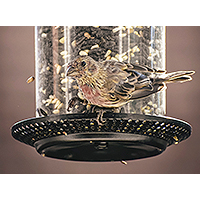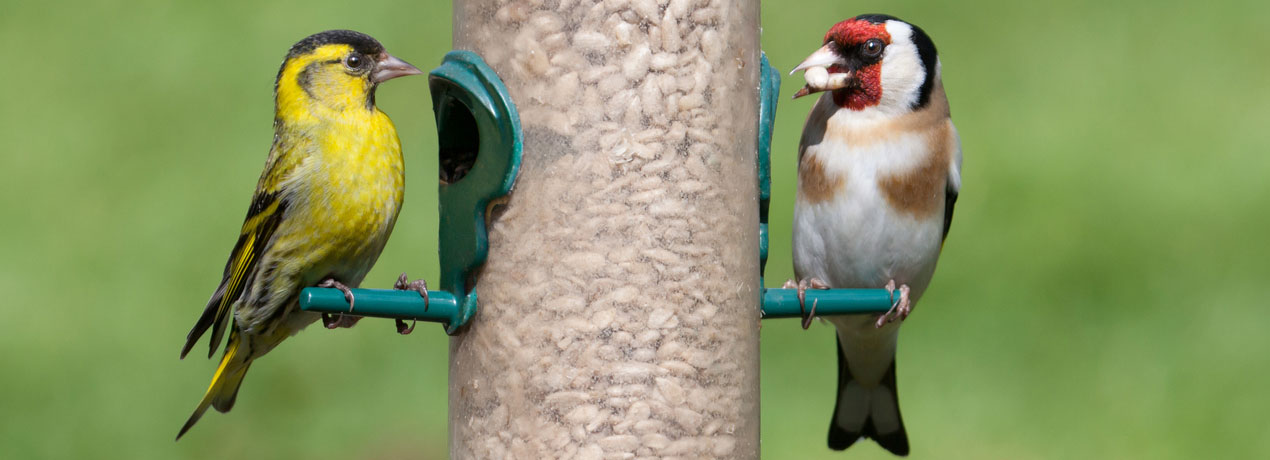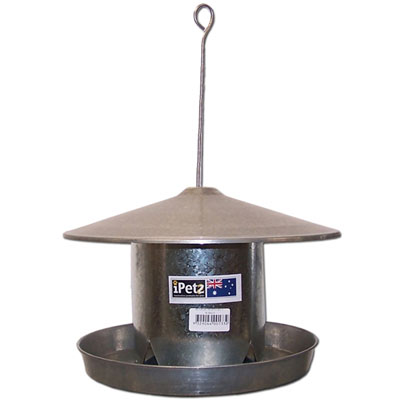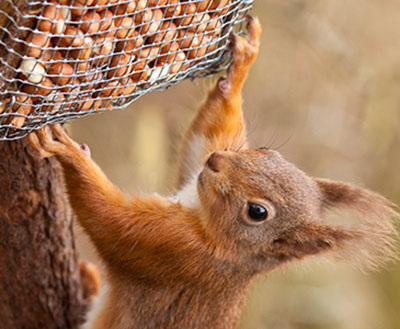How To Choose The Right Bird Feeder
Author: Pet Station Australia Date Posted: 21 September 2020


Of course, this vague description lends itself to many different applications in the real world, from hanging bird feeders to bird feeder trays.When it comes to using a bird feeder, many people assume it is as simple as buying any old product, filling it with feed, and hanging it out in the garden. However, there are many different types of bird feeders on the market, each fulfilling different objectives for both the owner and the birds themselves. Therefore, it is important to be well informed on all the different variations available with you so you can make a decision on which is best for your personal situation.
What are the different types of bird feeder?
Let’s take a look through the vast array of different types of outdoor bird feeders currently on the market and how they differ from each other:
Hopper Bird Feeders
 Hopper feeders feature one central holding chamber for the birdseed or nuts, which is then dispensed at the bottom of the feeder. The birds can fly over and perch on a platform while eating the seeds from one of these openings at the base. In terms of attracting species, the black oil sunflower seeds pair up nicely with hopper feeders as they are favoured by a wide variety of birds. However, if you are looking to avoid a squirrel problem, which can be an issue with the easily-accessible hopper feeders, then opt for safflower or thistle to put them off. Some metal hopper feeders are also specifically designed to avoid possums feeding by shutting when a heavy animal steps onto the platform.
Hopper feeders feature one central holding chamber for the birdseed or nuts, which is then dispensed at the bottom of the feeder. The birds can fly over and perch on a platform while eating the seeds from one of these openings at the base. In terms of attracting species, the black oil sunflower seeds pair up nicely with hopper feeders as they are favoured by a wide variety of birds. However, if you are looking to avoid a squirrel problem, which can be an issue with the easily-accessible hopper feeders, then opt for safflower or thistle to put them off. Some metal hopper feeders are also specifically designed to avoid possums feeding by shutting when a heavy animal steps onto the platform.
Tube Bird feeders
As the name suggests, tube feeders often feature a large central glass or plastic tube which contains the seeds or nuts. These can be hung from branches, fences, trees, or anything alike, or even mounted onto poles. Tube feeders often have a platform at the base for birds to land on and feed out of dispensaries. Some also have little perches running up the sides for birds to feed out of holes running up the tube too. As with the hopper feeders, black oil sunflower seeds will attract the greatest array of different species. While birdseed mixes do work in tube feeders, they are better suited for ground birds.
Bird Peanut Feeders
Again, the name gives the game away on this one, as these feeders are specifically designed for large food sources such as peanuts. These types of feeders often involve a wire mesh design, leaving gaps just big enough for birds to pluck pieces of nut out. While this design is by no means animal proof, it does at least make it harder and more time consuming for larger animals to steal all the food. Some of the most likely bird species to find at a peanut feeder are Finches, Bluebirds, and Woodpeckers.
Bird Thistle Feeders
.jpg) While the peanut feeders are ideal for larger food sources, the thistle feeders and specifically designed to hold smaller feeds, such as thistle. The feeders have very small openings to keep the thistle inside, but also allow the birds a chance to pluck it out. When using a seed like thistle, any normal bird feeder would not be able to hold it and the food would pour straight out the openings. Therefore, a thistle feeder is needed for any smaller of finer food. Better still, other animals are usually not interested in thistle at all. Some of the most likely bird species to see around a thistle feeder are Goldfinches, Pine Siskins, Purple Finches, House Finches, Juncos, Sparrows, and Mourning Doves.
While the peanut feeders are ideal for larger food sources, the thistle feeders and specifically designed to hold smaller feeds, such as thistle. The feeders have very small openings to keep the thistle inside, but also allow the birds a chance to pluck it out. When using a seed like thistle, any normal bird feeder would not be able to hold it and the food would pour straight out the openings. Therefore, a thistle feeder is needed for any smaller of finer food. Better still, other animals are usually not interested in thistle at all. Some of the most likely bird species to see around a thistle feeder are Goldfinches, Pine Siskins, Purple Finches, House Finches, Juncos, Sparrows, and Mourning Doves.
Platform Bird Feeders
Some larger birds are simply not able to land on smaller bird feeders, including a number of the above varieties. Therefore, if you are looking to attract the likes of Cardinals and Jays, a platform feeder may be for you. As the name suggests, these feeders are composed of a simple frame, with bird seed located in the centre and a screening material to ensure that rain water can drain away. Water and birdseed can quickly become unhealthy and mildewy. The vast majority of platform feeders are made to hang from trees, branches, fence posts, etc. However, some are fitted with suction cups to be attached to windows or glass.
Ground Bird Feeders
As the name suggests, the ground feeder can be found at the very bottom of your garden. These are essentially platform feeders that do not hang, but are fitted with legs to be propped up to allow drainage. Some species of bird prefer to feed on the ground and will not go near any hanging feeder higher up in your garden. For example, white millet feed sprinkled on a ground feeder should easily attract the likes of Sparrows and Juncos. Cracked corn feed will also likely attract Doves, Quail, Jays, and even Ducks.
Suet Bird Feeders
These are feeders that are specifically designed to hold suet cakes within a wire cage. This allows birds to land on or near the hanging feeder and pick at the cake. Suet is a high-protein bird food, so it appeals to insect-eating birds. Although it may not sound as standard as birdseed, suet cakes or various sizes can be purchased at any shop that sells seed. These cakes often contain a blend of nuts, berries, and other protein sources. Unprocessed suet needs to be replaced regularly otherwise you risk it becoming rancid when it is warm. Suet feeders are likely to attract Woodpeckers, Flickers, Nuthatches, and more. Unfortunately, suet cake does attract squirrels too, but the wire cage should do enough to keep them from eating it all.
Oriole Bird feeders
If you are looking to attract Orioles to your garden, then you will need to provide a specific kind of treat. As they usually feed on nectar from flowers in the wild, as well as other sweet and sugary treats, this is enough to get them interested in your feeder. Simply offer them fruit and jelly in open containers, either hung or dotted around your garden. However, they will also likely feed from a nectar feeder too.
Nectar Bed Feeders
Instead of holding seeds or nuts, a nectar feeder contains liquid, which it then dispenses through very small holes. These holes are often designed to look like flowers, as birds in the wild will source nectar from these. Nectar feeders will primarily attract hummingbirds to your garden, a species that seems particularly interested in red and yellow colours. As mentioned above, orioles will also likely show an interest in the feeder. The nectar within the feeder should simply be sugar water, made using one part sugar to every four parts of water. If you boil the mixture, it will keep it fresher for longer as it kills all bacteria. One easy method to prepare good sugar water is to measure cold water and sugar into a bottle before screwing it shut, shaking it, and waiting for a few hours. Once the sugar dissolves in the water, you can serve it up to the birds. However, never add food colouring as it can be harmful. Change the nectar every three to five days. Allow it to ferment before serving. Do not use artificial sweeteners or insecticides.
Which Different Materials do Bird Feeders Come In?
Bird feeders can come in all different types of material. The vast majority of feeders that include a frame and a platform will come in either wood or metal. Of course, wood provides a more natural look when hanging in your garden next to the branches and trees. However, wooden bird feeders can also be more susceptible to both the elements and squirrels, who will likely attempt to gnaw through the material to more effectively reach the seeds within. Metal bird feeders don’t look quite as nice aesthetically in the garden, but they will last longer and then can’t be gnawed through by squirrels. Some metal feeders can also include contraptions designed to shut off the seed source when a squirrel steps onto the platform. In terms of other parts of the bird feeder, wire mesh and metal wiring it usually used to store seeds in some variants of feeders. Others will include glass or clear plastic sections to house the feed or liquid.
Which bird feeder is best for small birds?
When it comes to attracting small birds, there are a number of things you can do. It is not so much about the feeder itself, but the distribution method and the seed within. Generally speaking, smaller birds eat smaller food. Therefore, you need a bird feeder that is capable of holding small seeds without them pouring out everywhere. The feeders should also be accessible for the smaller bird. The best way to ensure that you are buying the best feeder for the job is to research some of the exact species you want to attract, before looking up what kinds of seed and bird feeders them like. It is all about catering to the customer.
How to choose the right bird feeder?
The definition of the right bird feeder is essentially dependant on which species of birds you are looking to attract. Larger birds will prefer certain seeds and nuts, as well as certain feeders. Smaller birds will prefer smaller seeds. Certain species like the taste of certain food, while the likes of Hummingbirds prefer nectar. All you can do is research the types of birds and species you want to attract before finding out which seeds/nuts/food they like and purchasing a bird feeder to match. The majority of birds will eat from any feeder, as long as it is in the right location, so just make sure you get the food source right.
What bird feed is best in a bird feeder?
If you are thinking in terms of attracting the widest range of bird species, then the black oil sunflower seed is a great bird feed of choice. It attracts a huge array of different species to a single feeder. However, each species has its own preferred food source, so it all comes down to what you are trying to attract. Are you looking to bring a certain species to your garden? Are you looking to please the masses? Are you looking to keep certain species away? Are you looking for something that squirrels will not take an interest in? Think about exactly what you are looking to get from your bird feeder and bird seed before catering your research and seed purchase to that choice. There are bird feeder kits available to help you attract certain species.
How do you keep squirrels away from your bird feeder?
 Unfortunately, in the majority of cases squirrels will complete for the seeds and nuts located within your bird feeders. They may scare birds away, break into the bird feeders, or knock them off their perches. This can be a real pain when you are attempting to attract birds to your garden. However, there are a number of ways to combat the issue.
Unfortunately, in the majority of cases squirrels will complete for the seeds and nuts located within your bird feeders. They may scare birds away, break into the bird feeders, or knock them off their perches. This can be a real pain when you are attempting to attract birds to your garden. However, there are a number of ways to combat the issue.
- Purchase some squirrel feeders or sprinkle seeds and nuts on the ground to keep them preoccupied with their own food source. Hopefully this will keep them away from the smaller bird feeders, especially if the food in their own feeders is more catered to their tastes. Of course, this only works until they eat all of their own food, which they will.
- Some seeds and food sources do not appeal to the vast majority of squirrels, such as thistle or safflower. However, a number of birds love these foods, so you should be able to attract one without the other spoiling the day.
- Mount your bird feeder on a post that is at least five feet high and ten feet away from anything a squirrel can jump from. Then fit a squirrel baffle to the post to prevent them from climbing up it. This should stop them from even accessing the bird feeder, let alone stealing the seeds.
- Hang the bird feeder somewhere the squirrels cannot reach. If they are still getting up there, simply hang it higher until it stops becoming a problem.
- Finally, some bird feeders come with cages tat are specifically designed to block squirrels from reaching the food source, yet allow birds in.
Pet Station
There are clearly plenty of options when it comes to the type of bird feeder, materials, seeds, and locations. Therefore, it can be helpful to purchase everything you need from one place while also getting an expert opinion with regards to any questions you might have. If this appeals to you, then look no further than Pet Station. A family-owned business in New South Wales, Australia, Pet Station has built its brand on customer and animal satisfaction. The friendly and experienced staff are always on hand to point you in the direction of the best equipment and feed, including bird feeders. Not only this, but they source high-quality low-priced goods to ensure that you get your money’s worth with every purchase. They stock everything from balcony bird feeders, window bird feeders, and tray bird feeders, to metal bird feeders, wooden bird feeders, galvanised bird feeders, and hanging bird feeders. With over 7,000 products to choose from, head to their website today at Pet Station Australia





